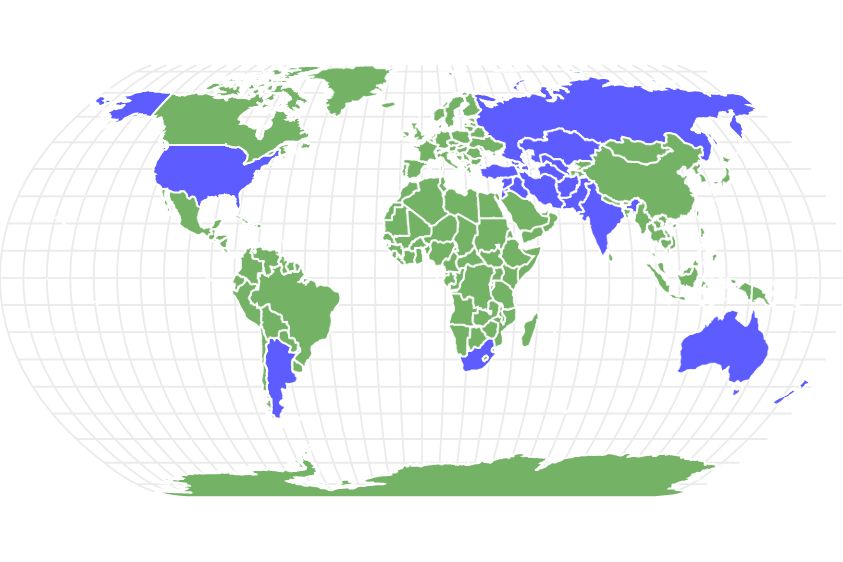Angora Goat
Capra aegagrus hircus
Each adult Angora goat produces about 12 inches of mohair annually while kids have about 8 inches.
Advertisement
Angora Goat Scientific Classification
- Kingdom
- Animalia
- Phylum
- Chordata
- Class
- Mammalia
- Order
- Artiodactyla
- Family
- Bovidae
- Genus
- Capra
- Scientific Name
- Capra aegagrus hircus
Read our Complete Guide to Classification of Animals.
Angora Goat Conservation Status
Angora Goat Facts
- Name Of Young
- Kid
- Group Behavior
- Herd
- Fun Fact
- Each adult Angora goat produces about 12 inches of mohair annually while kids have about 8 inches.
- Biggest Threat
- Coyotes
- Most Distinctive Feature
- Angora goats produce mohair fiber.
- Other Name(s)
- Angoras
- Gestation Period
- 150 days
- Litter Size
- 1
- Habitat
- Farms
- Predators
- Coyotes
- Diet
- Herbivore
- Type
- Mammals
- Common Name
- Angora goats
- Number Of Species
- 1
- Location
- Worldwide
- Group
- Flock
Angora Goat Physical Characteristics
- Color
- Red
- Black
- White
- Skin Type
- Hair
- Lifespan
- 10 years
- Weight
- 82kg-100kg (180lbs-220lbs)
- Height
- 91cm-122cm(38in-48in)
- Length
- 127cm(50in)
- Age of Sexual Maturity
- 6-7 months
- Age of Weaning
- 4-6 months
View all of the Angora Goat images!
If you want a warm mohair sweater or scarf, raise an Angora goat and make your own.
The hair on Angora goats should grow about 1 inch per month. These animals originated in Angora in Asia Minor between 1571 and 1451 B.C. Even though they look like sheep, they are not a close relative. While throughout history, these goats have produced white hair, breeders have introduced colored Angora goats.
5 Incredible Angora Goat Facts!
- Ideally, Angora goats are shaved when the fibers are between 4.7-and-5.9-inches long.
- Angora goats are raised worldwide, with the United States, South Africa, and Turkey being the largest producers.
- Each Angora goat is shaved twice yearly to collect the fiber.
- Adult Angora goats produce about 10.6 pounds of mohair annually.
- Angora goats are the only goat that produces hair.
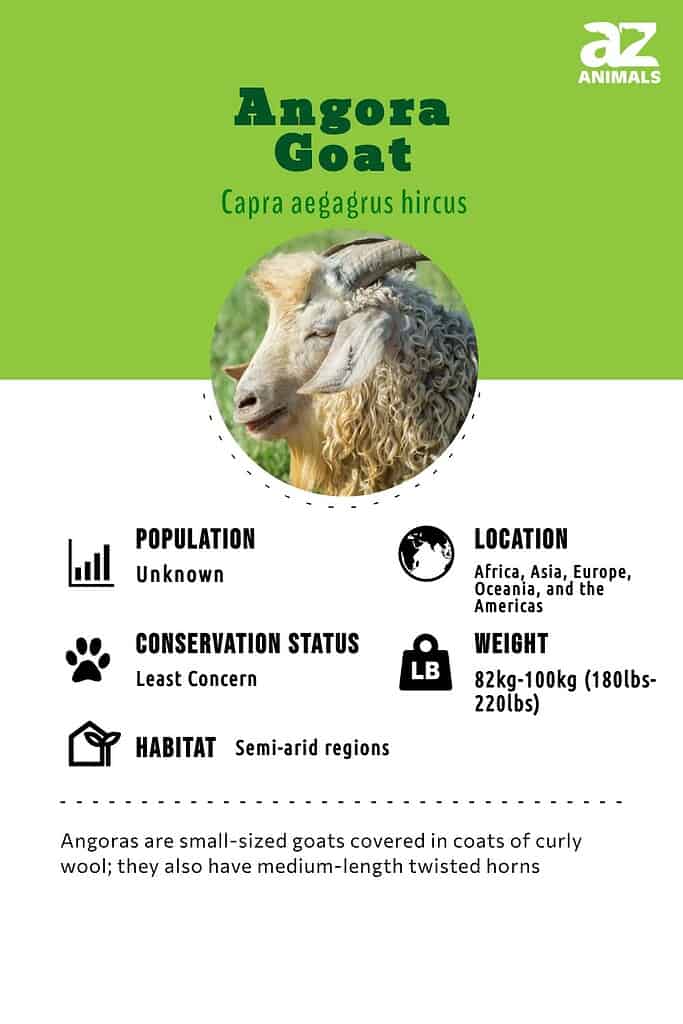
Scientific Name
Like all goats, the scientific name of Angora goats is Capra aegagrus hircus. Angora is a breed.
No one is sure of the exact facts of the history of Angora goats. Their origin is not precisely recorded. Ther origin appears to have started in Asia Minor about 1571 and 1451 B.C. They were imported into the United States in about 1849 and into Europe in about 1554. In 1900, history records that the American Angora Goat Breeders Association was formed to keep track of the ancestry of these domesticated goats.
Appearance
Angora goats stand about 42 inches tall and weigh about 200 pounds when mature. Both bucks and ewes have tannish-brown horns that should be pointed backward towards their bodies. The horns should be at least 2 inches apart, and they can be up to 24 inches long. Each horn has a spiral shape. A soft downy-like substance covers their faces and ears.
The body of the Angora goat should have even hair covering it. These domesticated goats should have a broad chest and a level back. Each part of the goat’s body should be well-muscled.
Except for below the knees, the goat’s body should be covered in hair. The hair should feel soft when handled. It grows at the rate of about 1 inch per month. It should fall in soft ringlets so that it does not appear rope-like. The curls should be of uniform density and length all over the animal’s body.
Mohair
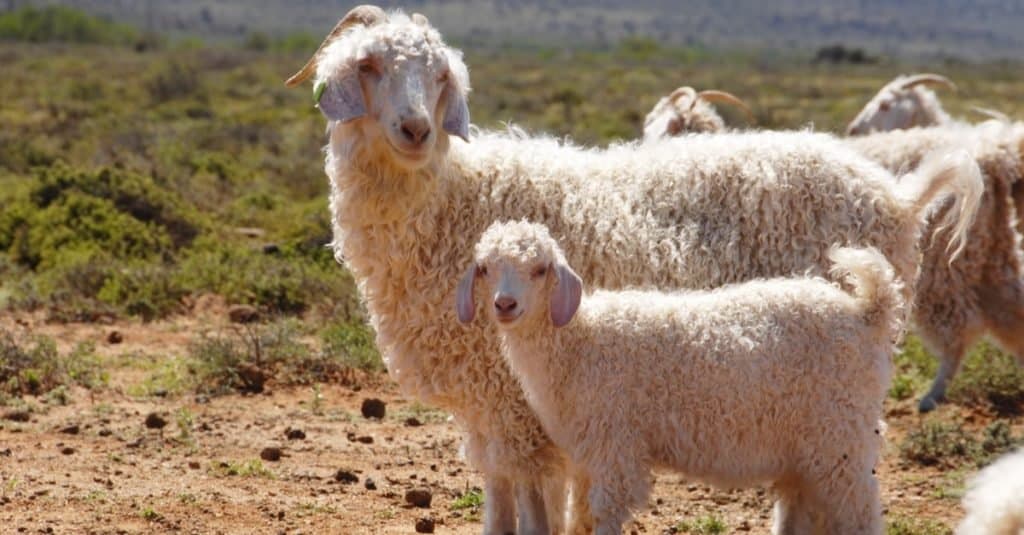
Each strand of mohair on an Angora can grow up to 15 inches long
©Janice Adlam/Shutterstock.com
Mohair is an important hair-like fiber that grows over the Angora goat’s body. This animal is the only one that produces it. The strands can grow up to 15 inches long, and farmers sheer the goats twice a year to collect it.
Mohair is different from Angora wool, which comes from Angora rabbits. The mohair fibers are mostly keratin, which is the same substance found in human fingernails. While history does not record an exact starting point, mohair was likely being made into yarn used to make clothing a long time ago in Turkey. One of the first mentions of mohair clothing comes from England during the 8th century.
Many sewers love to work with mohair, which they call the diamond fabric. Compared to sheep’s wool, it is softer and has a sheen to it. While some producers raise colored Angora goats, the fiber also takes dyes very well.
Commercially, mohair is worth different prices based on its quality. Usually, younger animals produce more delicate mohair that brings a higher price than older animals. Additionally, goats often get lice. Therefore, it is necessary to treat lice regularly to increase the value of the mohair.
Evolution and Classification
Due to its status as a domesticated goat, the Angora goat belongs to the genus Capra. The domestication of this large family actually took place during the Mesolithic era, 10,000 years ago in Northern Iran. However, some experts assert that the event may have occurred during the early part of the Neolithic period (the era itself extended from 3,000 – 8,000 years ago). Evidence has also been found of their domestication in Western Asia as far back as the mid-Mesolithic and the early Neolithic.
These bovids along with sheep were the very first animals to be domesticated. Being part of the Capra genus means that these mammals known for their silken coats are also related to ibexes, markhor, and turs. The ancestor of the Angora goat is believed to be the bezoar ibex, which is also the forebear of all goats.
Behavior
Angora goats are friendly animals. When compared to many other goat breeds, these animals have a more laid-back attitude.
Nonetheless, they are curious animals that will often try to get into areas where farmers think they have them blocked to see what is there. Therefore, most farmers use a five-strand electric fence to try to keep the Angora goat where it belongs.
Habitat
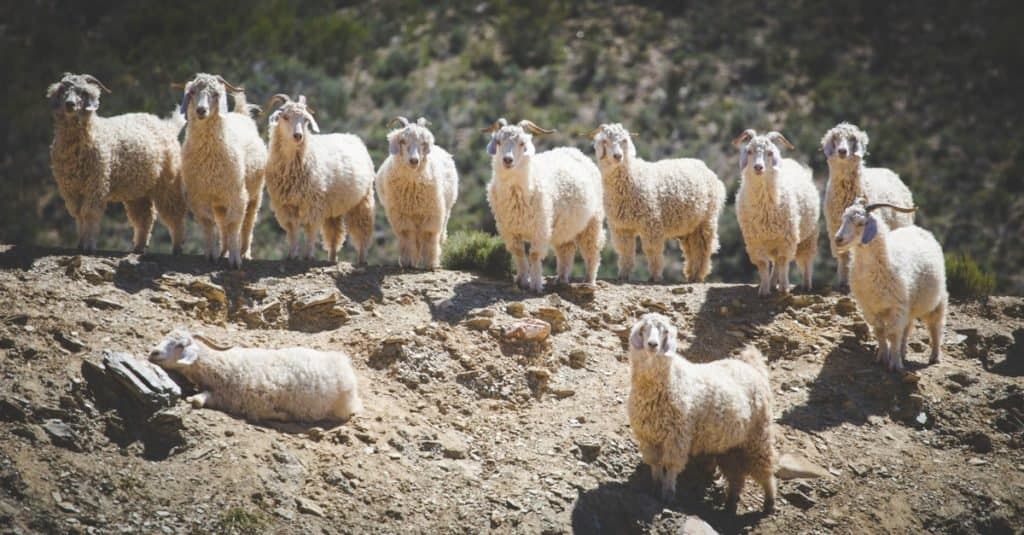
Angora goats can be raised with cattle and their presence may actually be beneficial to them
©Dewald Kirsten/Shutterstock.com
South Africa is the largest producer of mohair. Therefore, farmers raise more Angora goats there than anywhere else.
In the United States, over 90% of mohair that goes on the commercial market comes from Texas. These animals are grown on farms throughout the Southern United States. Farmers must be conscientious that the goats live in clean conditions as excessive dirt in the mohair lowers its price considerably.
Farmers often raise Angora goats in the same pastures as domestic cattle and sheep. Since they each have a different diet, there is no competition for food. Angora goats can be particularly good at controlling Canadian thistle, multiflora roses, and sand burs. This allows the pasture to produce more food for the other animals.
Diet
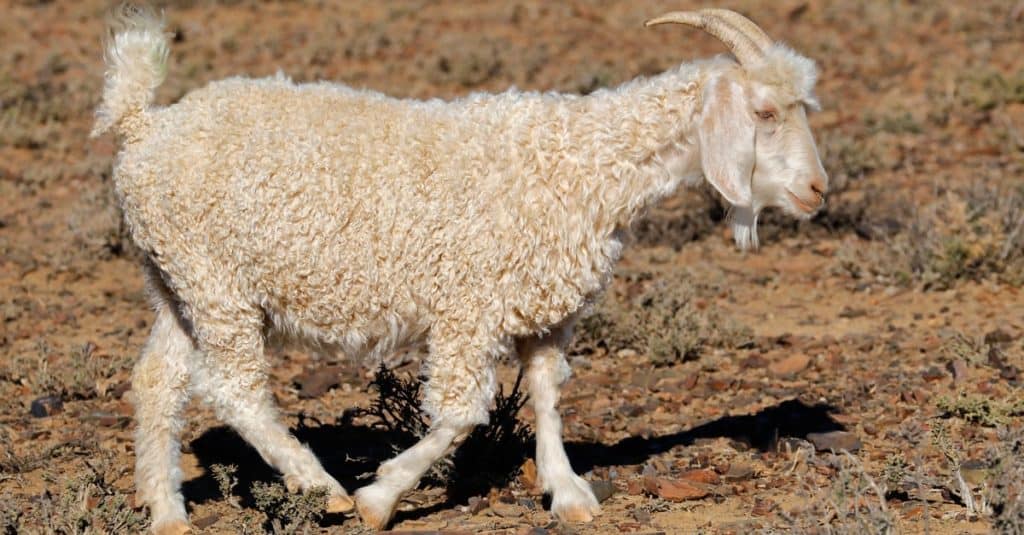
Angora goats may need supplemental feeding during weaning and breeding, and near kidding
©EcoPrint/Shutterstock.com
The Angora goat must get a good diet because its body is designed to grow the hair first before using nutrients to keep the animal healthy. They need access to a good quality pasture at all times.
Supplemental feeding may be necessary at weaning, during the breeding period, and near kidding. When supplemental feeding is required, then protein, carbohydrates, minerals, and vitamins are essential. Farmers often provide these through feeding corn, soybean meal, or a commercially prepared supplement.
Predators and Threats

Coyote are one of the main predators of Angora goats
©sebartz/Shutterstock.com
The two main predators of these goats are dogs and coyotes. Many farmers use an electric fence to keep these predators out of the area where they are raising their goats.
One of the most significant threats to these goats is internal parasites. Therefore, farmers must deworm their animals regularly. Roundworm is a continual threat affecting the amount and quality of mohair. Managing roundworms in goats can be particularly challenging because these goats metabolize anthelmintics faster than most goats, causing the roundworm to become immune to the drug designed to kill them.
Reproduction and Life Cycle
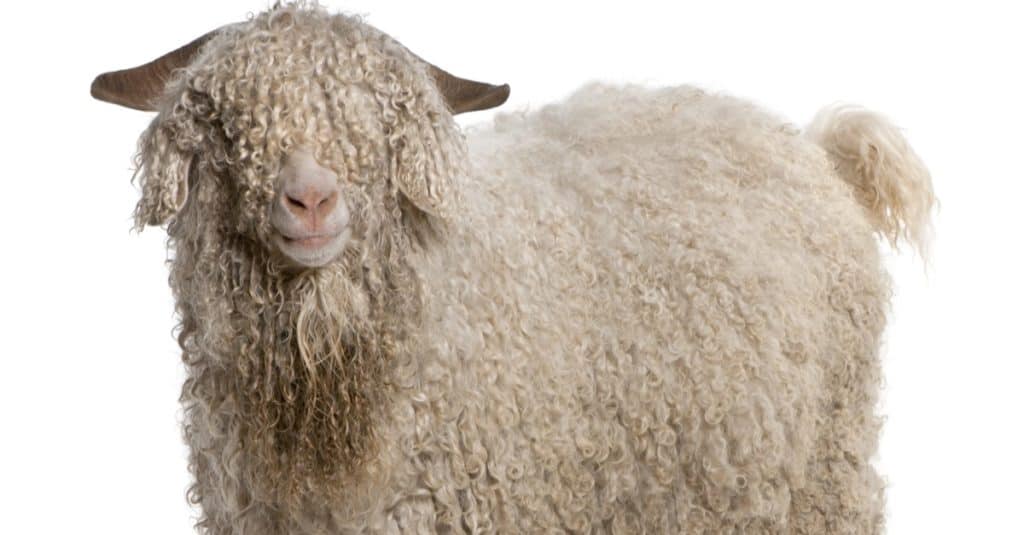
Most female goats live up to 14-15 years and remain fertile for a significant part of their lives
©iStock.com/GlobalP
Many of these goat raisers choose to artificially inseminate their animals because it helps increase genetics in their herd while hopefully introducing weak traits in their current stock. Most ranchers choose to leave the buck with the doe for 19-to-21 days before separating them again.
Farmers should take several steps before breeding. First, they should clip the ewe so that there is no long hair. Next, the nutrients in the feed should be increased. Finally, they should deworm the animal for parasites.
When a farmer decides to breed is a personal decision. Most goats start to come into heat in the early fall. Some ranchers, especially those who want to show their goats, try to breed as early as possible while others try to wait a while so that cold weather will be over in the spring before kids are born.
While it is labor-intensive, most ranchers choose to bring their does to a confined area where they can carefully watch them before they kid. This helps to protect kids from predators while they are most vulnerable. It also makes it easier to help ewes who may have trouble accepting their young or have a problem during the birthing process.
Does often live to be 14 or 15 years old and can have kids yearly until they are 12 or 13.
Population
No one is sure how many of these goats are in the world. The largest population is found in South Africa, followed by the United States.
View all 194 animals that start with AAngora Goat FAQs (Frequently Asked Questions)
How Much Is an Angora Goat?
Each animal costs about $300 to $350. The cost of an Angora goat varies by quality. Top-quality animals are more expensive starting than lesser quality animals. A top male Angora goat that is a proven breeder will usually be the most costly.
Are Angora Goats Friendly?
Yes, Angora goats are docile and friendly.
Where Are Angora Goats Found?
Angora goats are found throughout the world, including in Turkey where they have their origins in Asia Minor. South Africa and the United States are the largest producers of these animals.
How Long Does an Angora Goat Live?
Angora goats live for approximately 10 years. Farmers can continue to use them for breeding until about 2 years before their deaths. Furthermore, they will continue to grow mohair throughout their lives.
Thank you for reading! Have some feedback for us? Contact the AZ Animals editorial team.
Sources
- The American Angora Goat Breeders Association Breed Standard For Angora Goats / Accessed June 19, 2021
- Angora Goats: A 'Shear' Delight! / Accessed June 19, 2021
- Boer Goat Profit Guide / Accessed June 19, 2021
- Your 4-H Angora Goat Project / Accessed June 19, 2021
- Livestock At Home / Accessed June 19, 2021
- Thought Co / Accessed June 19, 2021
- University of California Small Farms / Accessed June 19, 2021

